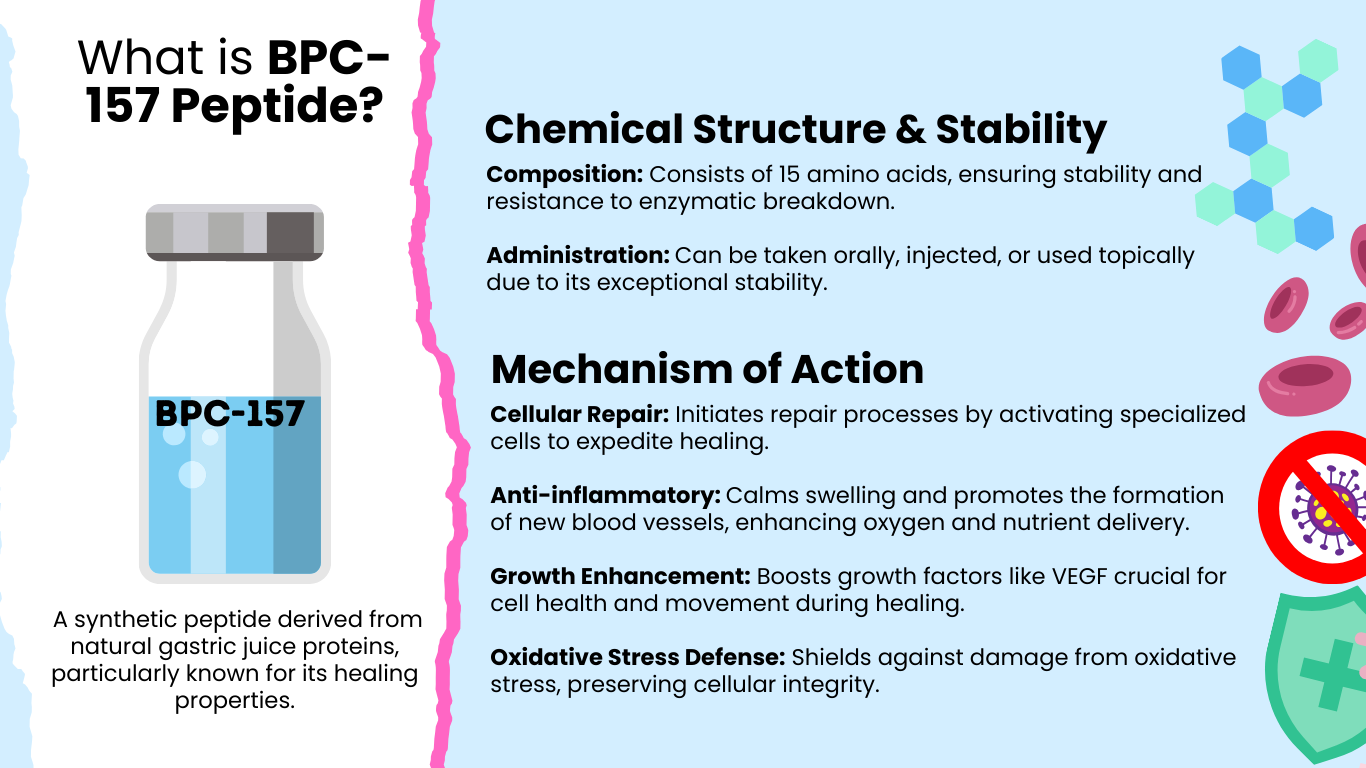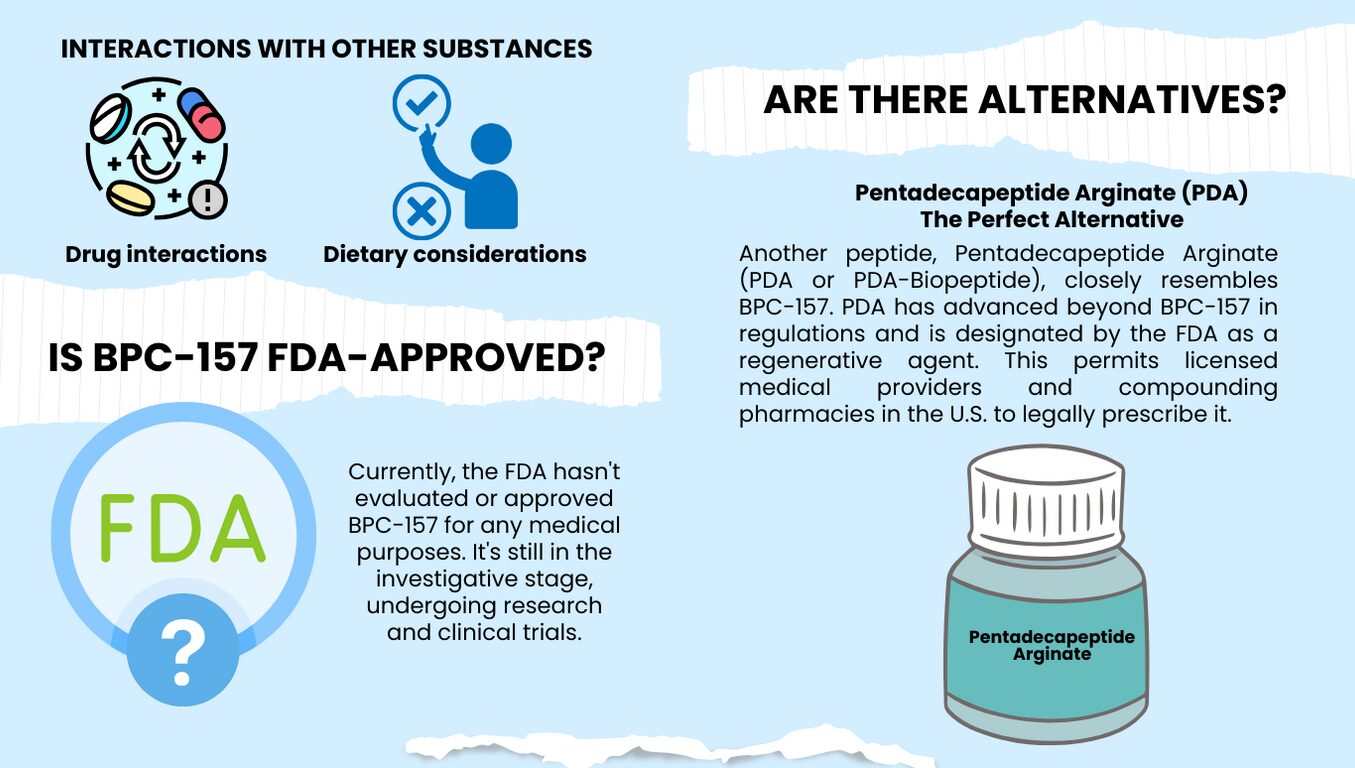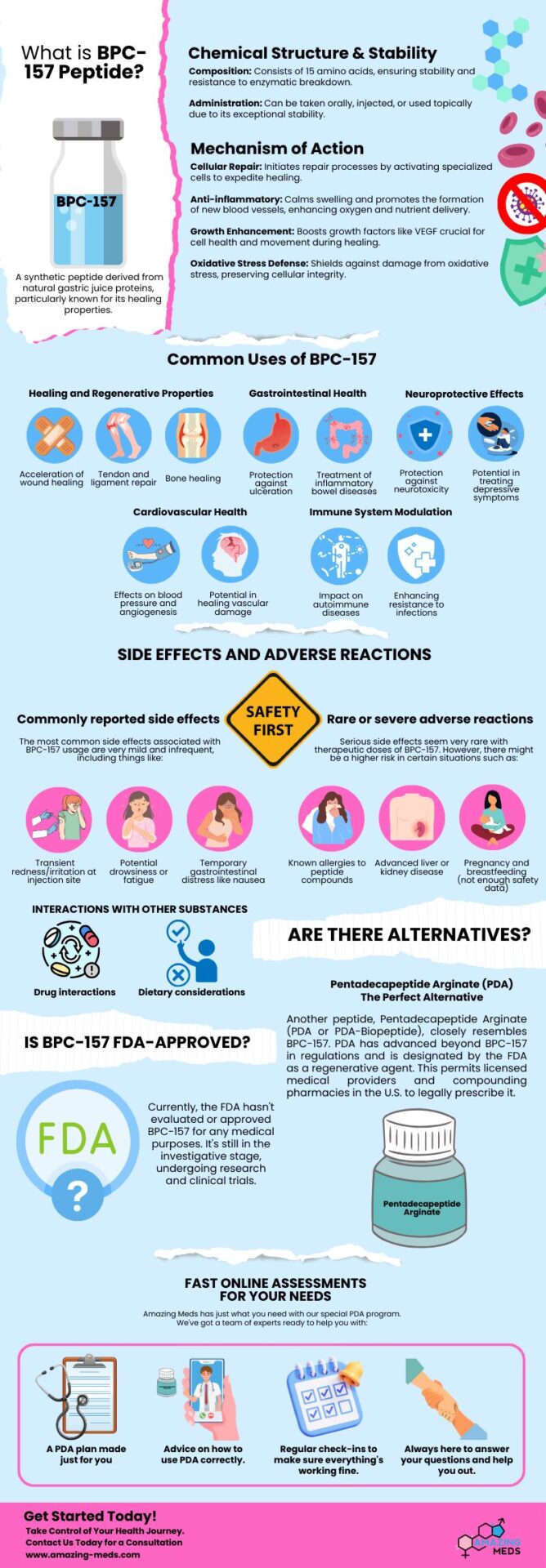What is BPC-157 Peptide? Is it Safe & What is it Used For?

You may have heard about a special peptide called BPC-157. People say it can heal many things, like sports injuries and leaky gut. But what exactly is it? Is it even safe to use? And could it actually live up to all the hype?
It’s common to feel unsure about new ‘cure-all’ trends in wellness. Many people have mixed feelings about them. Everybody’s trying to sell you the next big thing these days.
But BPC-157, or its kosher alternative that we’ll talk about, is worth looking into. The scientific evidence supporting its healing and protective abilities is quite convincing.
This guide will explain everything about BPC-157, like where it comes from, how it works, its benefits, safety, and how to use it properly. By the end, you’ll be able to decide if adding BPC-157 to your health routine is right for you.
What is BPC-157?
Definition and origins
BPC-157 is a synthetic peptide made from a protein found naturally in stomach gastric juice. Yes, you read that right – this “miracle” healing agent was inspired by the digestive fluids in our own bellies!
In the 1990s, researchers at the University of Zagreb in Croatia made a significant discovery. They were studying protective substances in the gastrointestinal lining when they stumbled upon BPC-157. By isolating a partial sequence of the “Body Protection Compound,” they created the 15-amino acid peptide now known as BPC-157. [1]
Chemical structure and stability
From a technical standpoint, BPC-157 is a pentadecapeptide consisting of 15 amino acids in its sequence. Its chemical structure is highly stable and resistant to being broken down by enzymes in the body.
Due to its exceptional stability, BPC-157 can effectively travel throughout the body and exert its effects systemically. This applies whether it’s administered orally, injected, or used topically. Its half-life is estimated to be around 6-7 days in humans. [2]
Mechanism of action at the cellular level
So how exactly does this peptide work its apparent “magic”? The mechanisms of action are multi-faceted:
- BPC-157 starts the repair process in our body by waking up special cells. These cells rush to where the injury is and help heal it faster.
- BPC-157 works in two ways. First, it helps calm swelling in the body. Second, it helps create new blood paths. This helps blood flow better and brings more oxygen and nutrients to where they’re needed. [3]
- BPC-157 boosts important growth helpers like VEGF. These helpers are key for cell health, growth, and movement during healing. [3]
- It shields against damage from oxidative stress and fights off toxins, keeping cells and tissues in good shape. [4]
Essentially, BPC-157 enhances and optimizes the body’s natural healing and protective mechanisms.

What is BPC-157 Commonly Used For?
Given its broad impact on key body processes, it’s no wonder BPC-157 could be helpful for many health issues.
Here are some of the most promising areas:
1. Healing and Regenerative Properties
Acceleration of wound healing
Many studies show that BPC-157 can quickly heal tough wounds, burns, and serious injuries. It works well for healing everything from skin cuts to corneal burns. [5]
Tendon and ligament repair
BPC-157 is well-known for quickly healing sprains, tears, and other injuries to soft tissues like tendons and ligaments. Many reports show it leads to faster and fuller recoveries with less scarring. [6]
Bone healing
Studies in animals suggest BPC-157 helps form calluses and grow bones back together after breaks. Research on its effects in humans is still developing. [7]
2. Gastrointestinal Health
Protection against ulceration
Since BPC-157 comes from a compound that protects the stomach, a lot of research has looked at how it can heal stomach and intestinal ulcers. It also helps prevent more harm from NSAIDs (pain relievers that don’t have steroids) and other issues. [8]
Treatment of inflammatory bowel diseases (IBD)
Trials in animals and humans show BPC-157 might help treat inflammation problems like Crohn’s, colitis, and “leaky gut.” It works by reducing inflammation and repairing the lining of the gut. [9]
3. Neuroprotective Effects
Protection against neurotoxicity
Early studies suggest BPC-157 can protect brain cells from toxins and might even help grow new ones. This is promising for treating conditions like Alzheimer’s, Parkinson’s, or recovering from injuries. [10]
Potential in treating depressive symptoms
Animal studies link BPC-157 to mood-lifting and anxiety-reducing effects. More studies are needed to see if it can help with mood disorders. [11]
4. Cardiovascular Health
Effects on blood pressure and angiogenesis
BPC-157 has been shown to act as both a vasodilator and angiogenic agent. It works to widen blood vessels and encourage new blood vessel growth. This can lower blood pressure and is good news for heart health. [12]
Potential in healing vascular damage
BPC-157 helps grow new tiny blood vessels and protects the inner walls of blood vessels. This can help fix or reduce damage from conditions like hardening of the arteries or diabetes.
5. Immune System Modulation
Impact on autoimmune diseases
BPC-157’s anti-inflammatory and immune system-balancing effects might offer new treatment possibilities for autoimmune diseases such as rheumatoid arthritis and multiple sclerosis. [13]
Enhancing resistance to infections
BPC-157 may help boost immune defenses and resist bacterial, fungal or viral infections – a promising area for future research.
Is BPC-157 Safe?
With such a long list of potential benefits, the million dollar question is: Is BPC-157 actually safe to use, especially long-term? Let’s look at what the research says:
Summary of clinical studies and research data
Most data on BPC-157 comes from tests on animals. However, it has also been studied in humans, mainly for healing purposes such as fixing tendons after ACL surgery. [14]
When taken orally or systemically at therapeutic doses, BPC-157 showed a good safety record. No serious side effects were reported in several trials. But remember, these studies were mostly short-term.

Side effects and adverse reactions
Commonly reported side effects
The most common side effects associated with BPC-157 usage are very mild and infrequent, including things like:
- Transient redness/irritation at injection site (topical is better tolerated)
- Potential drowsiness or fatigue
- Temporary gastrointestinal distress like nausea
Rare or severe adverse reactions
Serious side effects seem very rare with therapeutic doses of BPC-157. However, there might be a higher risk in certain situations such as:
- Known allergies to peptide compounds
- Advanced liver or kidney disease
- Pregnancy and breastfeeding (not enough safety data)
Interactions with other substances
Drug interactions
There aren’t any significant known interactions between BPC-157 and other drugs. Still, it’s a good idea to inform your doctor about any medications or supplements you’re using. This helps them assess any possible risks.
Dietary considerations
Using BPC-157 orally is usually safe with most foods and drinks. Yet, drinking alcohol might reduce its effectiveness, so it’s best avoided during treatment.

Is BPC-157 FDA-Approved? Are There Alternatives?
FDA stance on BPC-157
Currently, the FDA hasn’t evaluated or approved BPC-157 for any medical purposes. It’s still in the investigative stage, undergoing research and clinical trials.
Pentadecapeptide Arginate (PDA) – The Perfect Alternative
Yet, there’s another peptide called Pentadecapeptide Arginate (PDA or PDA-Biopeptide), closely resembling BPC-157. PDA has progressed ahead of BPC-157 in regulations. It’s the same version with the same 15 amino acid sequence as BPC-157, but with an added arginate salt for better stability.
Importantly, PDA has been designated by the FDA as a regenerative/regenerative stimulating agent. This allows licensed medical providers and compounding pharmacies in the U.S. to legally prescribe it.
How to get PDA prescribed by Amazing Meds
At Amazing Meds, our medical practitioners routinely prescribe the top-quality PDA peptide to patients after an evaluation and personalized treatment plan. With our nationwide network of partner compounding pharmacies, we can get this healing peptide conveniently delivered to your doorstep.
Just reach out to our team for an online consultation to get started! We’re proud to be at the forefront of bringing cutting-edge, clinically-validated regenerative therapies directly to discerning patients.

Frequently Asked Questions About BPC-157
How is BPC-157 made?
BPC-157 is produced in laboratories through a process called chemical synthesis. In this process, specific chemicals are combined in a controlled environment to create the peptide.
How does BPC-157 work in the body?
BPC-157 works by triggering various healing processes in the body. It stimulates the migration of specialized cells to the site of injury, where they promote tissue repair and regeneration. Additionally, BPC-157 reduces inflammation and encourages the formation of new blood vessels, which helps deliver essential nutrients and oxygen to the injured area, aiding in the healing process.
What are the main benefits of using BPC-157?
BPC-157 offers a range of potential benefits for health and healing. It can accelerate the healing of injuries to tendons, ligaments, bones, and skin. Additionally, it may protect and repair the gastrointestinal tract, promote brain health, support cardiovascular function, and modulate the immune system, potentially offering relief for various health conditions.
Can BPC-157 help with joint and muscle injuries?
Yes, BPC-157 has shown promise in aiding the recovery of joint and muscle injuries. It can help repair damage to tendons, ligaments, and muscles, promoting faster healing and reducing the risk of complications. Additionally, it may alleviate pain and improve mobility in affected areas.
How can BPC-157 be used in bodybuilding and sports?
In the bodybuilding/fitness world, BPC-157 is often used to support recovery from training-related injuries and enhance overall performance. By accelerating the healing process and reducing inflammation, it can help athletes recover more quickly from intense workouts and competitions, allowing for consistent training and performance gains.
What are the recommended dosages for BPC-157?
The typical dosage of BPC-157 ranges from 200 to 1000 micrograms per day, depending on the severity of the condition being treated. It is often divided into 1-2 doses throughout the day for optimal effectiveness. However, it’s crucial to follow the guidance of a healthcare professional to determine the appropriate dosage for individual needs and circumstances.
How should BPC-157 be administered for maximum efficacy?
BPC-157 can be administered orally, topically, or through subcutaneous injections. While oral administration is convenient, injections tend to provide more consistent and reliable results as the peptide is absorbed directly into the bloodstream. Your healthcare provider can help determine the most suitable administration method based on your specific health goals and preferences.
Can BPC-157 be taken orally, or does it have to be injected?
Yes, BPC-157 can be taken orally, although it may require higher doses compared to injections to achieve similar effects due to differences in absorption. Oral administration is convenient for some individuals but may result in less predictable outcomes compared to injections. It’s essential to discuss the pros and cons with your healthcare provider before deciding on the preferred method of administration.
How long does it take to see results from BPC-157?
While individual responses may vary, many people report noticing improvements in their condition within 1 to 2 weeks of starting BPC-157 therapy. However, the full extent of benefits may take longer to manifest, particularly for chronic or severe conditions. Consistency in use and adherence to recommended dosages are key factors in achieving optimal results.
Is BPC-157 legal, and can it be purchased freely?
BPC-157 is not currently approved by the FDA for medical use, so it cannot be legally obtained over-the-counter. To ensure safety and efficacy, it’s essential to obtain BPC-157 from licensed healthcare providers who can prescribe it based on individual health needs and conditions.
Can BPC-157 be used in conjunction with other peptides or medications?
Yes, BPC-157 can be used alongside other peptides or medications under the guidance of a healthcare professional. However, it’s important to consult with your doctor to ensure compatibility and minimize the risk of adverse interactions. Your healthcare provider can provide personalized recommendations based on your specific health profile and treatment goals.
Are there any known contraindications for using BPC-157?
While considered very safe overall, BPC-157 use may need to be avoided or closely monitored in individuals with:
- Liver or kidney disease
- Allergies to peptide compounds
- Active cancers or malignancies
- Current pregnancy or breastfeeding
How does BPC-157 influence recovery from surgery or injuries?
BPC-157 speeds up the body’s healing process, helping recover from surgeries, injuries, and illnesses quicker. It helps tissues heal better and prevents scars from forming, so recovery is smoother.
Can BPC-157 help with conditions like arthritis or fibromyalgia?
BPC-157 seems to reduce inflammation and repair tissues, which can help with arthritis, fibromyalgia, and similar conditions. It may ease pain and stiffness in joints and muscles.
What’s the current stance of the FDA on BPC-157?
The FDA hasn’t approved BPC-157 yet for medical use. It’s still being tested in studies to see how safe and effective it is. However, similar peptides like PDA are allowed for prescription use.
What precautions should be taken while using BPC-157?
Always use BPC-157 under a medical expert’’s guidance. Stick to the prescribed dosage, watch out for allergies or side effects, and avoid drinking alcohol during treatment.
Is BPC-157 FDA-Approved?
No, BPC-157 isn’t approved by the FDA for medical use yet. It’s still being studied to make sure it’s safe and works well.
Why is Pentadecapeptide Arginate (PDA) the perfect alternative?
PDA works similarly to BPC-157 but has an extra ingredient for better stability. Also, PDA is FDA-approved for certain medical uses, unlike BPC-157.
Where can one find reputable sources of Pentadecapeptide Arginate (PDA)?
You can get high-quality PDA from licensed healthcare providers like Amazing Meds. We’ll make sure you get the right kind and dosage through trusted pharmacies.
Talk to a Healthcare Provider First
Thinking about trying PDA? Always talk to a healthcare provider first.
Your health is unique, and a healthcare provider can give you advice that fits just you. They help make sure the choices you’re thinking about are safe and right for your health goals.
Seeing a healthcare provider is a smart move before starting any new supplement. They’re your partner in making good choices for your health.
So, before you decide, reach out to a healthcare provider. It’s a simple step that makes a big difference.
Amazing Meds: Doctor-Prescribed PDA, the #1 BPC-157 Alternative
Looking for the healing benefits of BPC-157 but want something high quality and legal? Amazing Meds has just what you need with our special PDA program.
We’ve got a team of experts ready to help you with:
Quick online checks and tests to figure out what you need.
- A PDA plan made just for you.
- Advice on how to use PDA correctly.
- Regular check-ins to make sure everything’s working fine.
- Always here to answer your questions and help you out.
And we only get our PDA from pharmacies we trust, so it’s always safe and top-notch.
Don’t risk your health with iffy BPC-157 sources. Come to Amazing Meds for PDA, a cutting-edge option for better health.
Ready to feel better with PDA? Contact Amazing Meds now and get started on your path to healing!
What is BPC-157? A Visual Summary

References
- Hsieh MJ, Lee CH, Chueh HY, Chang GJ, Huang HY, Lin Y, Pang JS. Modulatory effects of BPC 157 on vasomotor tone and the activation of Src-Caveolin-1-endothelial nitric oxide synthase pathway. Sci Rep. 2020 Oct 13;10(1):17078. doi: 10.1038/s41598-020-74022-y. PMID: 33051481; PMCID: PMC7555539.
- Keremi B, Lohinai Z, Komora P, Duhaj S, Borsi K, Jobbagy-Ovari G, Kallo K, Szekely AD, Fazekas A, Dobo-Nagy C, Sikiric P, Varga G. Antiinflammatory effect of BPC 157 on experimental periodontitis in rats. J Physiol Pharmacol. 2009 Dec;60 Suppl 7:115-22. PMID: 20388954.




